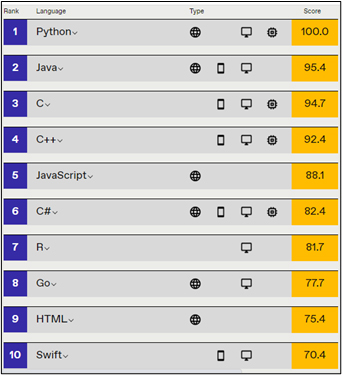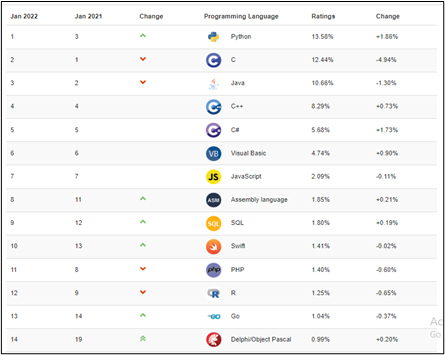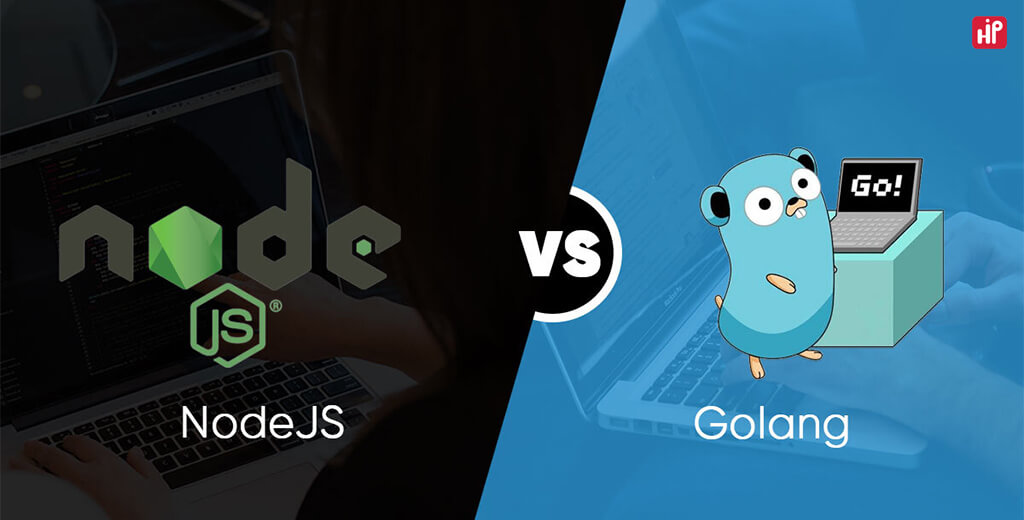Go Lang and Node Js – these two technologies are considered the most promising backend technologies by the developer community worldwide. They both were first released in 2009 basically to develop server-side and networking applications. Go and Node.js are insanely fast and they are both good with multi-threaded programs (parallel programming).
GoLang is today’s top-most popular programming language. It offers top-of-the-line productivity, as well as multi-core power. Contrary to Go, Node equips developers with a complete development environment along with all the tools they need to achieve their goals. In order to make an informed decision, we should be aware of the pros and cons of each language.
Brief Introduction of Node.JS
Node JS (first released in 2009 by Ryan Dahl) is the single-threaded, open-source, cross-platform runtime environment for building fast and scalable server-side and networking applications.
It is written in C, C++, and JavaScript and runs on Google V8 Engine (A virtual machine with a built-in interpreter, compiler, and optimizer which compiles JavaScript functions into machine code) well known for its speed and performance.
Node JS uses event-driven single-threaded non-blocking I/O architecture making it super fast and the first choice for Node.Js developers for developing real-time applications.
Node.js is an open-source, cross-platform, back-end JavaScript runtime environment that
runs on the V8 engine and executes JavaScript code outside a web browser. Wikipedia.
Key Points: – Easy, Scalable, Fast, Packages, Strong Backend, Multiplatform, Maintainable
Pros and Cons of using Node.js
There are some strengths and weaknesses to Node.js, and we’ve discussed them below, in order to figure out which projects may benefit from it.
Advantages of Node.Js:
The first Node.Js advantage that makes Node.js a great choice for most developers is its Java heritage. It is most popular right now with millions of free tools, a highly accessible library, and an active community. Currently, there are more than 400 million downloads and thousands of free tools in the package module
1. Reduces Time to market apps: time to market is one of the essential benchmarks of quality and performance for many. Since Node.js is lightweight it enables developers to accelerate the overall development speed.
2. Libraries: Highly extensible library, ready to use codes and other resources from GitHub which in turn saves a lot of coding time and effort.
3. Lesser loading time: Reduces loading time by quick caching.
As a matter of fact, The eBay team quickly embraced node.js advantage by adding it to their stack, since they wanted the application to be ultra-fast and manage live connections with the server in real-time. The Node.js framework proved to be the ideal resolution to handle a large number of data to display in microseconds.
4. Concurrent request handling: Since Node.js is providing the options of non-blocking I/O systems, it helps us to process requests simultaneously.
5. Ease of learning: Most front-end developers know JavaScript since it’s one of the most popular languages.
6. Scalable: we can easily add extra nodes to scale the application horizontally, and add a resource to scale the application vertically without affecting the entire application’s speed and performance.
Walmart benefited immensely by replacing its legacy systems with the deadly combination of microservices architecture and Node.js. The retail giant saw an instant growth in overall conversion of 20% and a 98% boost in mobile conversion. In addition, not only did they save 40% of the computing power, but they also slashed costs by 20-50%.
7. JSON support: One can use JSON to provide the scope for the exchange of data between the web server and the client. It has its built-in API for developing HTTP, DNS, TCP, etc… servers
8. Better performance: Multitasking without clogging RAM and its event loop and non-blocking I/O allows code execution at a pace both of these make Node.js highly performing.
9. Full-stack JS: Due to its full-stack JavaScript capabilities, Node.js can serve both client and server-side applications. This saves time and money since we don’t need to hire separate developers for front-end and back-end work.
By using node.js, LinkedIn’s development team was able to reduce server counts from 30 to 3. They also realized that resource delegation and utilization were more efficient since they were no longer focused on troubleshooting but instead were able to focus on application development.
10. Customized requirement: Node.js can be easily extended and customized for rapidly growing enterprises.
PayPal had a phenomenal 2013, as it processed $451 billion worth of payments in 2013 and had over 244 million active users at the end of the year. It was then that PayPal replaced Java with JavaScript and Node.js. The result was a significant reduction in page response time by 200ms and a huge increase in the number of requests they could handle.
11. Cross-platform: It can run across Windows, Mac, Linux without editing the code.
12. Extraordinary tech stack: It is a part of a popular MEAN tech stack ( the combination of MongoDB, Express.js, Angular, and Node.js – four tools that handle all crucial aspects of web app development) and this is the reason some experts assume that Node.Js is the future of web development.
Disadvantages of Node.Js:
- Based on JavaScript which is dynamically typed making it harder to debug
- APIs used in Node JS undergo changes frequently: Due to unstable API, the user is forced to continually change the access code to match in sync with the latest version.
- Uses asynchronous Programming: the asynchronous programming model makes it difficult to maintain code.
- Reduces performance when handling heavy Computing Tasks: though it’s single-threaded and event-driven, Node.js falls short at executing heavy CPU-based computing because of it. When Node.js receives a huge CPU-driven task in its loop, it utilizes all available CPU strength to accomplish it. Which decelerates event loop performance.
Brief Introduction of GoLang
GoLang is a procedural, multiparadigm, open-source programming statically typed, cross-platform, a lightning-fast programming language created by Google developers (that were unhappy with existing languages.) in 2009. It incorporates the best features of other programming languages, it is similar to C, C++ in terms of performance and security and it combines the speed of python. According to the words of Rob Pike “Go is supposed to combine the safety and performance of statically compiled languages with the lightness of dynamic RTP’d ones.”
Go is a statically tuned, compiled programming language designed at Google by Robert Griesemer, Rob Pike, and Ken Thompson. Go is syntactically similar to C, but with memory Safety, garbage collection, structural typing, and CSP – style concurrency. Wikipedia
Key Points: – Standard Library, speed, garbage collection, analysis tools.
Pros and cons of GoLang
It is no secret that GoLang programming language usage has grown rapidly in recent years. It seems that nearly every startup is using it for backend systems. There are many reasons that developers find it attractive, while there are a few points that make it less liked among programmers
Advantages of GoLang:
According to the TIOBE Index for GO, there has been a steady increase in the popularity of the Go language, it has gained one position more than the previous year. Securing its place at number 13.
1. Open Source: it is very important for a programming language to be open source to become better, cleaner, and more efficient. If a code has defects GoLang developers will detect and eliminate the problem.
By using open-source GoLang libraries, Dropbox has improved its caching, standard error interface, and connection management.
2. Learning curve isn’t steep: it’s easy to learn Go as it looks almost similar to other languages learned. The documentation is also easy.
3. Incredibly fast performance with heavy loads: Simple structure and syntax, devoid of class and inheritance, mainly works with functions so it’s simple and fast to learn. It is compiled so it provides faster feedback hence saving time and money.
GoLang is used by Daily Motion to automate API calls and end-to-end test cases. It is fast and powerful, so they choose GoLang for automating huge volumes of testing. Most backend projects are in GoLang because of its performance, static type checking, and simplicity.Even Twitch is using a combination of C++ and GoLang for delivering high-quality video streaming.
4. Ease of concurrency: with this open-source programming language concurrency is tractable and very easy. Requests are processed faster, freeing the resource for the network.
Uber which earlier used Node.js and Python has recently migrated to Go owing to its concurrency, and Go Memory model. They got high performance in throughput and latency. The response time was <5ms at the 95th percentile, and <50ms at the 99th percentile. They have written the Geobase program using GoLang.
5. Cross-platform: It can be compiled cross-platform to Windows, Android, Linux, and many more.
6. Easy Compilation: As Go has no virtual machine, it compiles directly to machine code.
7. Collecting Trash: The language makes it easier for the developers to perform activities like memory management by handling all runt work by itself.
8. The richness of the library: as it is adapted from C, C++, Java it has almost a collection of libraries similar to that of those.
9. Scalable: As it was designed by Google it was designed with scalability in mind and has many built-in functions to handle concurrency. An application can be scaled using Goroutines and Channels.
SendGrid’s earlier used python/Twisted has now switched to GoLang and they need to send over 500 million messages a day and they need a highly customizable, reliable, and scalable API. (Medium)
The fabric used GoLang for easy linear scaling and simplicity of code.
10. Cloud designing: Microservice and cloud computing are two great uses of Go. It is lightweight and cross-platform. Moreover, it compiles really quickly. So it is said to the language of the cloud.
Given its nature, Go is best suited to projects with growing user numbers and a large volume of requests.
Disadvantages of Golang:
- Metaprogramming: Developers need to code more to implement complex functionalities in Go.
- Non Reusable codes: It is harder to reuse code in Go than in other languages.
- It is new and still developing: being new language developers might find it difficult to make maximum use of the library. Lesser documented help is available.
- Lack of flexibility: this is a statically typed language that offers less flexibility of coding, as per those who prefer dynamically typed language.
- Too simple: in an effort to keep the programming language simple, several years of programming language progress are wasted.
- Poor runtime safety: the safety level is restricted mostly to compile-time to a certain extent to runtime. As it focuses on speed more
- GoLang doesn’t offer its own GUI Library.
What is Nodejs Vs GoLang Used for?
“Node JS is not a language but a runtime environment for Javascript,” which is useful for developing applications that require a persistent connection from the browser to the server and is often used for real-time applications like chat, news feeds, and web push notifications. It is intended to run on a dedicated HTTP server, the applications are event-based and run asynchronously.
GoLang is a procedural, multiparadigm, open-source, cross-platform, lightning-fast programming language created by Google developers in 2009 (dissatisfied with existing languages). Consequently, it combines the best functions of several programming languages, has similar performance and security characteristics to C, C++ with the speed of Python.
GoLang and Node.js Statistics and World Rankings
According to IEEE spectrum, the overall rating for Go is 8th where it is mostly famous for web as well as enterprise development needs, while that of JavaScript is 5th mostly for web application development.

According to TIOBE Index Go ranks 13th whereas Javascript ranks 7th for the year 2021

- To enhance the geofence lookup microservice, Uber even migrated from the Node.Js platform to GoLang in 2016.
- A Paypal released its report about the Java to Node.Js switching for their back-end operations for faster page serve and response time.
- Node.js is used by approximately 1.5% in the webserver of almost every well-known website. – Report by W3Techs
- Netflix observed a 70% reduction in startup time by adopting Node.Js – Report by Medium
- Golang has secured 5th rank as the most loved programming language – Survey and Report by Stack Overflow, 2020
Node.js vs GoLang – Big Names using them?
With the continuously changing requirements companies tend to switch to the latest or up-to-date tools and technologies in order to achieve the best performance. Below are some ‘BIG NAMES’ that adopted either node.js or GoLang depending upon their backend requirement. Some even migrated from node.js to go and vice versa.
| Companies using Node js | Companies using GoLang |
|---|---|
| Technology tools | Technology platform |
| Trello, Heroku, Coursera, Figma, Asana, Speed test | Dropbox, SendGrid |
| Websites | |
| NASA, Yandex, BBC, Washington Post, New York Times | |
| Online Booking | Online Booking |
| Uber | Uber, Delivery Hero, Trivago, Sixt |
| Ecommerce and retailers | Ecommerce |
| eBay, Walmart, Groupon | Alibaba, Allegro, Mercadolibre |
| Fintech and digital payment | Fintech |
| Citi Bank, Revolut | solarisBank, Monzo Bank, Capital One |
| Web browsing and hosting | Payment Processing |
| GoDaddy, Yahoo, Mozilla Firefox | American Express, PayPal, iZettle, Bolt |
| Streaming | Streaming |
| Netflix, Spotify | SoundCloud, Twitch, Movio, Dailymotion, youtube |
| Online blogging and networking platform | Chat Platform |
| Medium, LinkedIn, Twitter, UpWork | Stream, Clever, Slack |
| Data processing | Data processing |
| Samsara, TIBCO | Samsara, TIBCO |
| Real-time event Platform | Real-time event Platform |
| Riot Games, Nakama | Riot Games, Nakama, Farmville, Sarvest swap, Dawn of titans |
| Browsing and other | |
| Google, GOV.UK |
Node.js VS Golang – A complete Comparison guide.
Both Node.js and Go have distinctive advantages and disadvantages below. We have tried to highlight the differences depending on different parameters like architecture, speed, extendibility, error handling, syntax, universality, learning curve, and where to use.
| Node JS | GoLang |
|---|---|
| Architecture Refers to the structure of the software system. Explains how the software behaves. |
|
The architecture of Node JS helps in high speed and performance |
|
| Speed and performance Performance measures how quickly an application performs a task. The faster the code executes, the faster the response time. |
|
All the above points make Node JS perform with high speed and performance
So is slower than Compiled GoLang |
In terms of raw performance of memory-bound tasks, GoLang is a better option. |
|
Extendibility |
|
|
|
|
Error Handling |
|
| Node Js error handling mechanism is based on a throw and catches approach which is already quite popular among developers Though it sometimes displays some consistency issues at the end |
GoLang error handling demands explicit error checking to make it difficult to find the cause of the error Though the end result is consistent and flawless |
|
Syntax |
|
| Node JS syntax is quite similar to the browser’s JavaScript. Anyone familiar with Java can easily learn Node.js | GoLang syntax Is quite similar to that of C Language. |
|
Universality |
|
| Used for both backend and frontend development Used to develop web apps, desktop, and hybrid mobile apps, along with cloud IoT solutions Its cross-platform means a single desktop application that will work on Windows, Linux, and Mac. |
GoLang can be used mainly for back end development It’s cross-platform so the Go Program can run on Mac, Linux, and Windows Great for web and desktop development which need high security Weak for streaming |
|
Learning Curve |
|
| Node Js is one of the most widely used coding languages, easy to learn and switch. If the user is a little familiar with JavaScript he can easily use Node JS, so to learn node is easier | GoLang is a complete language. A web and Mobile App developer has to learn it from the start and be familiarized with its specific process, rules, interfaces, pointers, and other programming concepts |
| Where to use | |
| Real-time data streaming Low cost Less time Only one language |
High-performance Scalable apps Stringent security |
Node.JS Vs GoLang: Final Call
Although Node.js and GoLang are very different technologies, both are excellent choices for building robust and reliable backends. In development charts, Node.js often tops the list, but Go isn’t far behind. Both are renowned for their scalability, efficiency, and reliability. Node.js lacks concurrency and shows a decrease in performance where computing is required, Go seems less effective with real-time data streaming and intensive data processing.
Node.js is based on JavaScript and acts like a complete package (frontend as well as backend) while the use of Go is restricted to backend development only (one needs to hire an additional developer for the frontend). So before choosing any of this language we should strongly take into consideration the pros and cons of GoLang and Node.js
References and terms
- Open source is source code that is made freely available for possible modification and redistribution.
- Threaded: In computer science, a thread of execution is the smallest sequence of programmed instructions that can be managed independently by a scheduler, which is typically a part of the operating system.
- Cross-platform: software that is designed to work in several computing platforms.
- Full-stack: A full-stack web developer can be defined as a developer or engineer who works with both the front and back ends of a website or application
- MEAN tech Stack: MEAN(MongoDB, js, AngularJS (or Angular), and Node. js)[1] is a free and open-source JavaScript software stack for building dynamic websites and web applications.[2]
- API: An application programming interface(API) is a connection between computers or between computer programs
- Multiparadigm: Using or conforming to more than one paradigm. The multiparadigm programming language supports both object-oriented and aspect-oriented programming.
- Metaprogramming: Metaprogramming is a programming technique in which computer programs have the ability to treat other programs as their data. It means that a program can be designed to read, generate, analyze or transform other programs, and even modify itself while running.
Read More:
Node.js vs PHP: Which is better for backend development?
NodeJS vs AngularJS: Which is The Best For Your Project?

